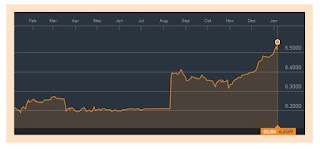These
survey numbers contradict real events.
Why?
Because
online job postings have been crashing in 2015 relative to 2014!
According
to online job agency, Monster.com, "The Monster Employment Index Philippines registered a -46%
year-on-year decline in online recruitment activities between
November 2014 and November 2015." (bold added)
It’s
not just November though, with the exception of December which has
yet to be posted, the entire 2015 have shown jobs growth numbers and
levels significantly well below the 2014!
And
it is NOT just Monster, two other employment indices which I monitor
have been exhibiting Monster’s dilemma.
Firm
A, one of the top online job sites, which used to owned by one of the
largest publicly listed holding company, has exhibited a 35% collapse
in online job postings from a week ago since May, when I began tabulating their
numbers!
Firm
A’s September bounce, echoes with Monster’s data. And so with the
November thud!
Firm
B hasn’t been as lucky as Firm A.
Firm B’s job opening numbers has
virtually evaporated! Since April, Firm B’s online jobs have
crumbled by a shocking 80% as of a week ago! Competition and the overall low job postings, perhaps led to the erosion of its market share.
While
employment data is nuanced than job openings, job openings give us
an insight on the conditions of job markets. Job openings provide a
clue of the hiring process and employment conditions.
Perhaps
employers have resorted to the traditional medium of newspaper based
advertisement, which should be more costly, and more inefficient in
drawing audiences or candidate employees.
Or
perhaps employers have resorted to direct hiring via viral
networking, without media advertisements.
Or
perhaps job openings have really been dwindling.
Nonetheless
based on online job openings the government’s statistical numbers
have been unsubstantiated.
This
simply tells us that the government’s numbers may be about
statistical Sadakos. Or that their numbers that just popped out of
the computer screens to generate a showbiz statistical talisman impact.
Yet Monster’s
November job opening collapse was broad based! The decline included the top
growth industries…yes, mainstream's favorite BPOs too (down by double digit)!
As
in June’s data where Monster.com tries to spin the bad developments,
as
noted here:
Online
jobs continue to nosedive. Monster.com’s June data reveals that
online hiring plunged 32% year on year. Yet they call this “a
significant improvement in growth from -43% in May 2015”. Huh?
Officers
from monster.com must have been scathingly
pilloried by
the throng of believers who think that the Philippines have reached a
developed economy status to force the latter to utter such
balderdash.
Monster
officials say that current job collapse has “Partly
due to the halting investments ahead of the elections and the dry
spells of the El Nino, hiring has also begin to slow down”.
But
they remain optimistic. They noted that job openings “will
likely see a rebound in 2016, given the country’s strong private
consumption as well as higher government spending in order to drive
growth in the country”
If
there has indeed been “strong private consumption” then why would
election or political uncertainty serve as a roadblock for
investments?
Have
the business community become so fearful of the change in
administration for them not to take advantage of opportunities from
the meme of “strong private consumption”? Or why has the business community
become (in aggregate) suddenly blind or dense to profit
opportunities?
Yet
the BSP tells us of a starkly different story: the business community have
supposedly been more upbeat in Q3
and Q4. If so, why the lack of investments? Who has been telling the truth or who
has been lying?
Second,
how has
the dry spells of the El Nino affected investments or job openings?
Agriculture accounted for just 8.57% share of 3Q constant based GDP,
whereas the Service sector had the largest share at 59.01%. Has there
not been a consumer boom to offset dislocations from the weather?
And
if Monster’s numbers accurately reflect on economic activities, then why the slump in ALL sectors?
As
for government spending, hasn’t there been a boom in government
spending?
Growth in government spending numbers has
reportedly accelerated 19.3% in 3Q relative to 12.4% in 2Q and
4.5% in 1H. Yet where are the jobs? Why has the surge in
government spending coincided with a collapse in the job opening
markets? Even if we see things in terms of a time lag, the 2Q
government spending activities should have at least buoyed job
opening numbers. So why the vacuum?
Could it be because job growth has emerged only in firms of crony enterprises benefiting from government spending projects in the exclusion of the rest?
Yes
the government's record low unemployment and all time high employment rates paradoxically comes in the face of slowing
statistical GDP, manufacturing and export recession, “halting of
investments” and collapsing online job postings. That's government's economic logic for you: Low is high, down is up, few is many.
And you
see, where (the phony) boom has been seen by the public or impressed
upon the public as a politically correct theme, any negatives has
to be denied, censored or rationalized by the mainstream's spin doctors.
At
the end of the day, panics are created by reality overwhelming embedded or entrenched misimpressions, misperceptions and deceptions.






























